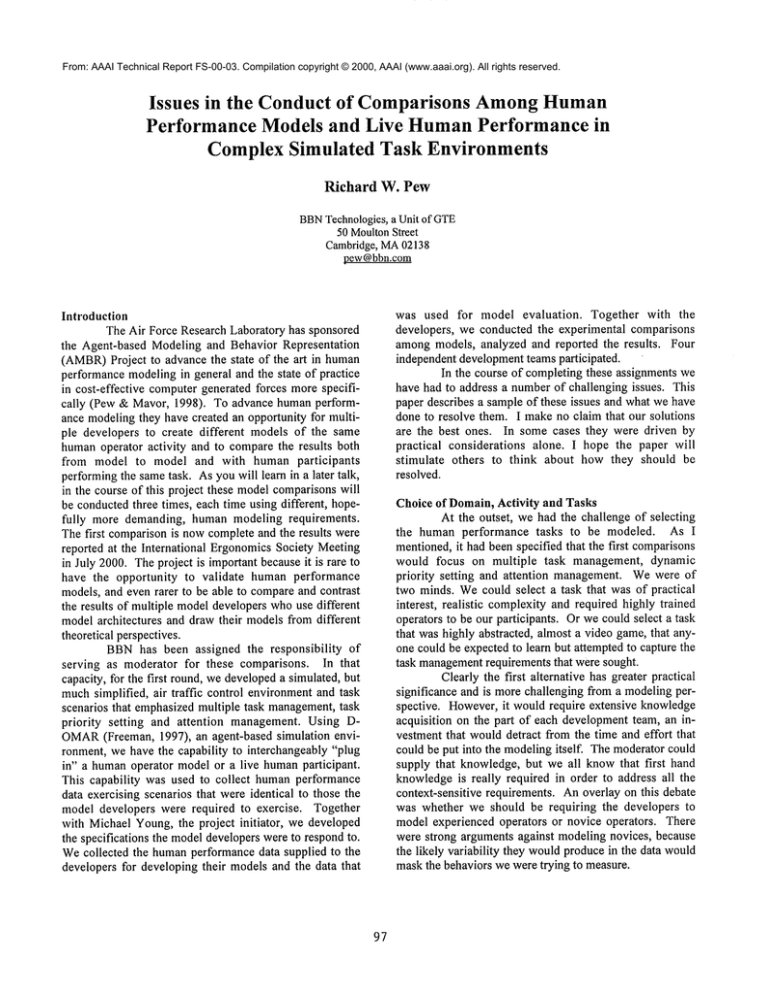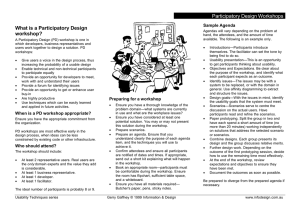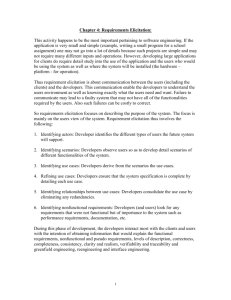
From: AAAI Technical Report FS-00-03. Compilation copyright © 2000, AAAI (www.aaai.org). All rights reserved.
Issues in the Conduct of Comparisons AmongHuman
Performance Models and Live HumanPerformance in
Complex Simulated Task Environments
Richard
W. Pew
BBNTechnologies, a Unit of GTE
50 MoultonStreet
Cambridge, MA02138
pew@bbn.com
was used for model evaluation.
Together with the
developers, we conducted the experimental comparisons
amongmodels, analyzed and reported the results. Four
independentdevelopmentteams participated.
In the course of completing these assignments we
have had to address a numberof challenging issues. This
paper describes a sample of these issues and what we have
done to resolve them. I makeno claim that our solutions
are the best ones. In some cases they were driven by
practical considerations alone. I hope the paper will
stimulate others to think about how they should be
resolved.
Introduction
The Air Force Research Laboratory has sponsored
the Agent-based Modeling and Behavior Representation
(AMBR)
Project to advance the state of the art in human
performancemodelingin general and the state of practice
in cost-effective computergenerated forces more specifically (Pew &Mavor,1998). To advance human performance modelingthey have created an opportunity for multiple developers to create different models of the same
humanoperator activity and to compare the results both
from model to model and with human participants
performingthe sametask. As you will learn in a later talk,
in the course of this project these modelcomparisonswill
be conducted three times, each time using different, hopefully more demanding, human modeling requirements.
The first comparisonis nowcomplete and the results were
reported at the International ErgonomicsSociety Meeting
in July 2000. The project is important because it is rare to
have the opportunity to validate human performance
models, and even rarer to be able to compareand contrast
the results of multiple modeldevelopers whouse different
model architectures and draw their models from different
theoretical perspectives.
BBNhas been assigned the responsibility
of
serving as moderator for these comparisons. In that
capacity, for the first round, we developeda simulated, but
muchsimplified, air traffic control environmentand task
scenarios that emphasizedmultiple task management,task
priority setting and attention management. Using DOMAR
(Freeman, 1997), an agent-based simulation environment, we have the capability to interchangeably "plug
in" a humanoperator model or a live humanparticipant.
This capability was used to collect humanperformance
data exercising scenarios that were identical to those the
model developers were required to exercise. Together
with Michael Young,the project initiator, we developed
the specifications the modeldevelopers were to respond to.
Wecollected the humanperformance data supplied to the
developers for developing their models and the data that
Choice of Domain,Activity and Tasks
At the outset, we had the challenge of selecting
the human performance tasks to be modeled. As I
mentioned,it had been specified that the first comparisons
would focus on multiple task management, dynamic
priority setting and attention management. Wewere of
two minds. Wecould select a task that was of practical
interest, realistic complexity and required highly trained
operators to be our participants. Or we could select a task
that was highly abstracted, almost a video game,that anyone could be expected to learn but attempted to capture the
task managementrequirements that were sought.
Clearly the first alternative has greater practical
significance and is more challenging from a modelingperspective. However,it would require extensive knowledge
acquisition on the part of each developmentteam, an investment that would detract from the time and effort that
could be put into the modelingitself. The moderatorcould
supply that knowledge, but we all knowthat first hand
knowledgeis really required in order to address all the
context-sensitive requirements. An overlay on this debate
was whether we should be requiring the developers to
model experienced operators or novice operators. There
were strong arguments against modeling novices, because
the likely variability they wouldproducein the data would
maskthe behaviors we were trying to measure.
97
Usingthe task of practical interest also had implications for the moderator team. Wehad limited resources
for collecting data. Either we wouldhave had to identify
and recruit experienced operators from the domain under
study, or we would have to invest in a very extensive
period of training.
As a practical matter we opted to use the highlyabstracted version of an air traffic control task and utilized
participants whohad played a lot of video games, but had
no previous experience with this task.. The task is
probably not as representative of multiple task management requirements as we could have achieved with a more
realistic task, but we obtained stable data from our human
participants in four-hour sessions and the modelers were
able to develop the requisite knowledgebased on their own
experience or that of a small set of previously untrained
subjects.
However,the results were not as clear cut as we
had hoped. Withoutgoing into too muchdetail, there were
two display conditions and three workload conditions
arranged in a factorial design. Weset it up so that there
wouldbe two sets of scenarios and two samples of 8 participants each. The data from one set of scenarios and one
sample of participants was provided to the developers for
creating their models. Then at the time of evaluation the
models were run on the second set of scenarios and
comparedto the data from the second sample of participants.. Wewerewilling to take the risk that the participant
samples wouldnot be equivalent, but we lost our bet. For
some of the performance measures the two samples producedpatterns of results that werenot entirely consistent.
Oncethis was discovered, we decided to combinethe data
from the two samples and run the models on both sets of
scenarios. This cleared up the problem and showed consistent effects of workloadand display type, but left us
with models that had been tuned on the basis of half the
data and evaluated on a combination of the tuning and
evaluation data. Weconcluded that, for the level of
practice we provided, 8 participants were just not enough
to produce reliable results. In the future we should use
moreparticipants or longer training periods or both.
mechanismsor humaninfrastructure that would produce
the required performance. Wewere thinking of memory,
attention, or perception mechanisms,for example, but, of
course, we could not predict what mechanisms each
modeler would build or assume. As a result, we had to
provide what we perceived to be as generally useful data
as possible. Furthermore, the data useful for developing
the models maynot be the same as data useful for evaluating them.
In addition, we had to think about what data it
would be possible to collect from the models as well as
from human participants.
Each of the models was
developed and run as an independent software module. As
the evaluators, we only had access to the data that was
explicitly provided to us through the application programming interface (API). Whenwe ran the models with our
test scenarios we could only measure data that passed
through the API. Weeither had to insist that the model
developers send certain specified data or else rely on the
data they needed to send to make the model work in our
environment for performance measurement. Since we
could not specify in advance what data they would make
available we had a problem being very specific in what
data we wouldrequire.
Our solution was to provide data on penalty
points, which was equivalent to outcomedata in the sense
that failures to perform tasks assigned or performing them
late contributed to penalty points. However,we had great
difficulty identifying sufficiently generic data that could be
useful for evaluating the structural details of the models.
Wesettled on collecting data on response times for the
most elemental task decomposition elements for which we
could reliably identify both a stimulus event and a
response event. Then we also required the model
developers to provide, derived from their theory and their
models’ performance, an estimate of workload level that
we could compare with human participant subjective
workload data for each condition as measured by the
NASATLX questionnaire.
In addition we provided a
trace of the time history of every action of each scenario
for each subject in case the model developers wished to
analyze it to obtain someother parameter or index. These
traces also madeit possible for the developers to rerun a
trial as performedby a participant and watch the resultant
activity on the ATC-likedisplays.
The penalty points did provide outcome data
related to modelperformance, but data from all the models
fell within the confidencebands established on the basis of
the standard error of the human data and where the
patterns were different there was no way to interpret the
differences in terms of the theory that went into the
models. Similarly all the models showed patterns of
results for the aggregate response time data consistent with
the humanresponse to the different treatment conditions.
Weare now decomposing the response time data to look
for more diagnostic results. The modeler’s each took a
different approach to modeling the subjective workload
data and the concepts adopted were interesting, but all
were able to adequately represent the trends in the data
WhatData To Collect
Wewere charged with collecting humanperformance data not only to provide to the modelers for
estimating various kinds of parameter values that might be
of interest and to develop their models, but also data for
validating and comparing one model result to another.
What data would be useful, feasible and practical to
collect?
Most applied experiments focus on outcomedata,
that is, data that evaluate the success of accomplishingthe
tasks assigned to the operators. Weobviously wanted to
obtain such data and considered it one important level at
which to evaluate the performanceof the models. Did they
produce the same level of success as typical humanparticipants? But we were also interested in encouraging
models that did not simply mimic outcome data. We
wanted them to simulate theoretically plausible internal
98
collected from humanparticipants. The bottom line is that
we were not very successful in identifying or forecasting
data that would discriminate amongthe models. It could
be that our task was not demandingenough or sophisticated enough to provide such data. However, I nowalso
believe it requires an understanding of the conceptual
underpinnings of the models ahead of time in order to
design the human data collection that will be truly
diagnostic.
SimulationFidelity
Finally, with respect to data comparisons, there
were issues of simulation fidelity and data consistency.
The human experimentation required that the external
events in the simulation run in "real time" and be consistent from trial to trial. Whilethis might seemsimple, the
simulation software was written in high level objectoriented languages, JAVAand LISP, for which we had
limited control of statement execution timing. If "garbage
collection" intervened or if statements requiring execution
piled up, it could cause irregularities in simulation timing.
Since a key kind of data we were collecting was timing
information, we needed some assurance that the timing
data we collected was not biased when we compared the
humanparticipant data with the modeldata and that there
were no interactions between details of the scenarios and
the computation delays for stimulus-response pairs. The
modeler’s were not restricted to run in real time. Their
models could run faster or slower than real time, as
necessary or practical. However,our participants , by
definition ran in real time.
Weadjusted parameters controlling the garbage
collector to prevent significant intervention by the garbage
collector during any of the humansubject trials.. In order
to assure ourselves, as confidently as we could, that the
data were reliable and unbiased representations of real
response times, weran repeated pilot trials in a variety of
scenarios representing the full range of task loads the
participants would experience on ourselves, as very
experiencedparticipants, and on initially naive participants
from the samepool as our ultimate participant population,.
Then we ran a simplistic modelin the same conditions and
examinedboth the repeatability across modelruns and the
very rough compatibility with the behavior of the human
participants. Weare confident that we have eliminated
biases, but we never aspired to achieving millisecond level
accuracy. Moreextensive cross calibration wouldbe necessary to enable us to say that the response times we were
measuringwere accurate to a quantitative level of confidence, such as +/- 200 msec.
Conclusion
Wehave been advocates of running comparisons
among human performance models on a commontask for
manyyears and have been delighted to be players in this
modeling comparison project. However,it is not as easy
as it seemsat first blush. There are issues that arise that
we, at least, never thought of until we found ourselves in
the middle of task development. Wehave elaborated a
sample of such issues but there are obviously manyothers.
99
In our opinion the importance of undertaking such comparisons far outweighs the limitations that we have encountered in accomplishing this one. It is the most enlightened way to push the frontiers in terms of model
architecture development as well as our understanding of
stable, productive methodologies for moving from architecture to detailed, robust humanperformancemodels.
Acknowledgements
I wish to thank mycolleagues, Yvette Tenney, Stephen
Deutsch, Sandra Spector and Brett Benyo, for many
contributions to this work. The project is sponsoredby the
U. S. Air Force Research Laboratory under Contract
F33615-99-C-6002, Dr. Michael Young and Dr. Kevin
Gluck, Project Monitors. Reproduction in whole or part is
permitted for any purpose of the United States
Government.
References
Freeman, B. (1997). OMARUser/Progr~tmmer Manual,
Version 2.0. BBNReport No. 8181. Cambridge, MA:BBN
Corporation.
(http:#www.he.afrl.af.mil/heslhesslprogramslomar/omardo
cs/index.html)
Pew, R. W. &Mavor, A. S. (1998) Modeling Humanand
Organizational Behavior. Washington DC: National
AcademyPress.





